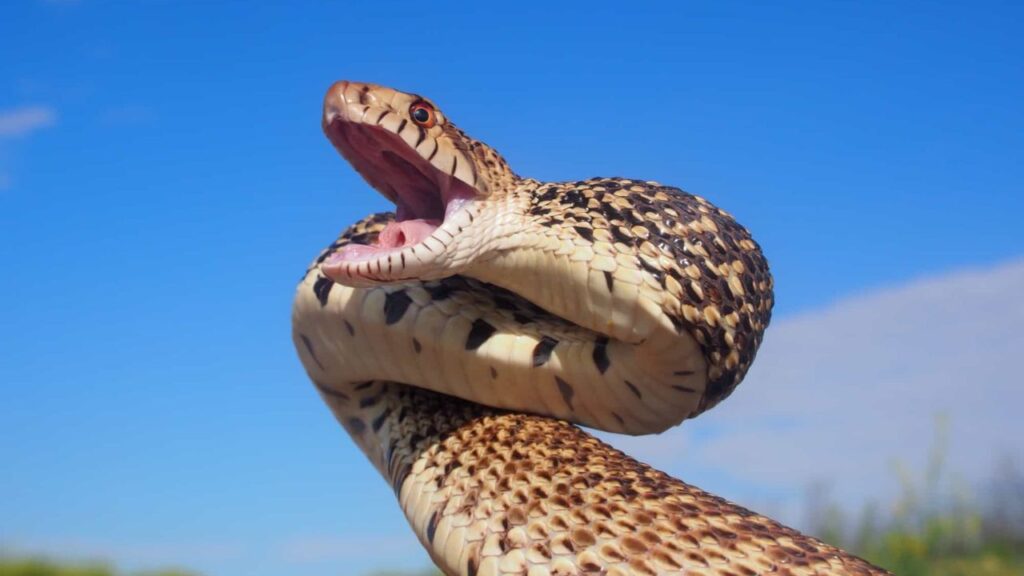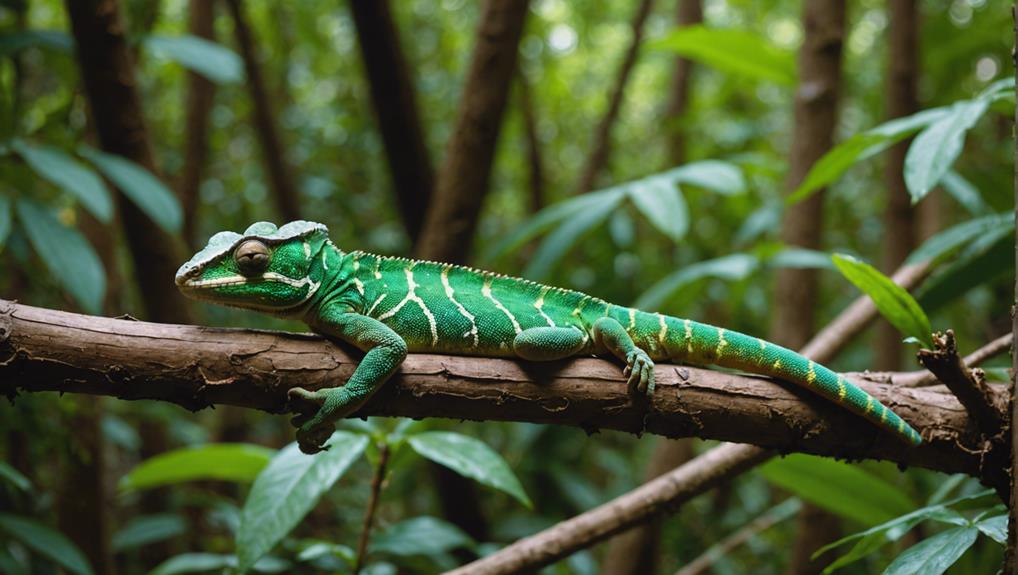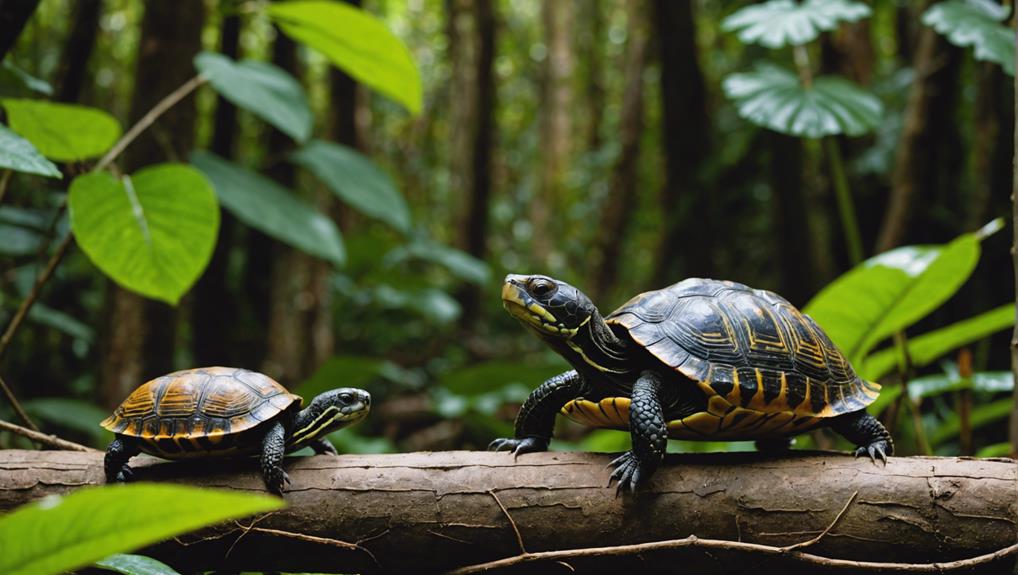You’ll spot bull snakes across Colorado in grasslands, forests, and even suburban areas. They’re 4 to 6 feet long, with yellow skin and brownish blotches, providing great camouflage.
These non-aggressive snakes are essential for controlling rodent populations, feeding on small mammals, birds, and insects. They use powerful constriction and strategic hunting techniques.
Bull snakes also employ defense mechanisms like vibrating their tails to mimic rattlesnakes. They’re skilled climbers and swimmers, thriving in semi-desert regions to riparian areas. Protecting their habitats helps maintain ecological balance.
Curious about their behavior and conservation? There’s quite a bit more to discover.
Appearance
Bullsnakes in Colorado stand out with their impressive length of 4 to 6 feet and their vibrant yellow skin adorned with brown and reddish blotches. When you encounter these snakes, you’ll immediately notice their striking color patterns. The yellow base color serves as a canvas for the dark brown and reddish spots that run down their backs, creating a distinctive and eye-catching appearance. This color combination not only makes them visually appealing but also helps them blend into their natural surroundings, providing some vital camouflage against predators.
In terms of size variations, bullsnakes can be quite large, especially compared to other non-venomous snakes in Colorado. Most bullsnakes you’ll see range between 4 to 6 feet in length, but some individuals can grow even longer. This considerable size makes them one of the largest snakes in the region, which can be both fascinating and intimidating to observe up close.
Despite their size, bullsnakes are generally not harmful to humans. Their size and appearance might make you think twice, but they play an essential role in controlling the populations of small mammals like mice, rats, and ground squirrels. Their robust bodies are built for constriction, allowing them to overpower and consume prey efficiently.
Behavior

While their striking appearance might catch your eye, it’s their fascinating behavior that truly showcases their adaptability and importance in the ecosystem. Bullsnakes are incredible predators, primarily feeding on rodents like mice, rats, pocket gophers, ground squirrels, and rabbits. This makes them essential for controlling rodent populations and maintaining ecological balance.
One of the most intriguing behaviors of bullsnakes is their use of tail vibrations and mimicry. When threatened, they might vibrate their tails against dry leaves or gravel, producing a sound similar to that of a rattlesnake. This clever form of mimicry can deter predators, providing the bullsnake with a means of self-protection. It’s a fascinating example of how animals adapt their behavior for survival.
In terms of predator-prey dynamics, bullsnakes are versatile and strategic hunters. They’re not just limited to one type of prey; their diet includes a variety of small mammals, which they hunt with remarkable efficiency. This versatility is partly due to their excellent climbing and swimming abilities, allowing them to navigate different terrains in search of food.
Bullsnakes are also known for their non-aggressive nature towards humans. Despite their size and somewhat intimidating appearance, they pose no threat to people. Instead, they play a crucial role in the ecosystem by keeping pest populations in check. This balance is essential for the health of various habitats where they reside.
Understanding the behavior of bullsnakes gives you a deeper appreciation for these remarkable reptiles and their role in the environment. They’re more than just another snake; they’re key players in the intricate web of life.
Habitat
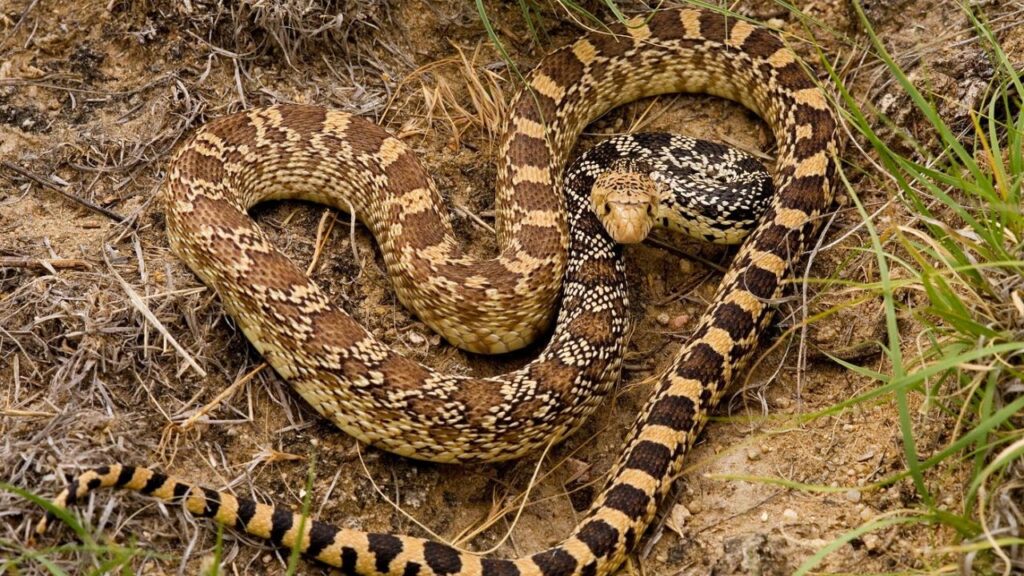
When exploring bull snakes in Colorado, you’ll find they inhabit a range of environments, from plains grasslands and sandhills to riparian areas and marshes.
Their adaptability allows them to thrive in rocky canyons, semi-desert regions, and even suburban neighborhoods. These skilled climbers and swimmers make use of diverse habitats to hunt and live, playing an important role in controlling rodent populations.
Diverse Snake Habitats
In Colorado, you’ll find bullsnakes thriving in a variety of environments, from plains grasslands to rocky canyons and suburban areas. These versatile snakes play important ecosystem roles by controlling rodent populations, which helps maintain ecological balance. Conservation efforts are essential to preserve their habitats and secure their survival.
Bullsnakes prefer climates that range from semi-desert regions to moist riparian areas. They’re commonly seen near ponds, lake edges, and in pinyon-juniper woodlands. Their presence in diverse habitats indicates stable population trends, though monitoring is necessary to address any potential threats.
You’ll often find bullsnakes in grassland and open brushland regions, showcasing their adaptability. They’re excellent climbers and swimmers, allowing them to navigate various terrains effectively. In rural and suburban areas, bullsnakes contribute to keeping pest populations in check, highlighting their importance beyond natural settings.
Understanding bullsnakes’ diverse habitats and climate preferences helps guide conservation efforts. By protecting their environments, you support the health of Colorado’s ecosystems. Continued research and monitoring of population trends are essential for the long-term preservation of these remarkable snakes.
Adaptability to Environment
Thanks to their remarkable adaptability, bullsnakes in Colorado thrive in a wide range of habitats including grasslands, rocky canyons, and suburban areas. Their environmental preferences are diverse, allowing them to inhabit plains grasslands, sandhills, riparian regions, and even marshes.
You can also find them around pond and lake edges, in semi-desert and mountain shrublands, and within pinyon-juniper woodlands. This adaptability showcases their effective survival strategies and ability to select suitable habitats within Colorado’s ecosystem diversity.
Bullsnakes are particularly common in grassland and open brushland environments, highlighting their versatility. Their success in these varied habitats contributes significantly to controlling rodent populations, which benefits the broader ecosystem.
To emphasize their adaptability:
- Habitat versatility: Bullsnakes are found in areas ranging from rural to suburban settings.
- Key survival strategies: These snakes thrive in both moist and arid conditions.
- Ecosystem impact: They play an important role in maintaining rodent population balance.
Understanding the habitat selection and environmental preferences of bullsnakes helps in promoting conservation efforts. By protecting and preserving the diverse environments where bullsnakes reside, you contribute to maintaining Colorado’s rich ecosystem diversity.
Diet
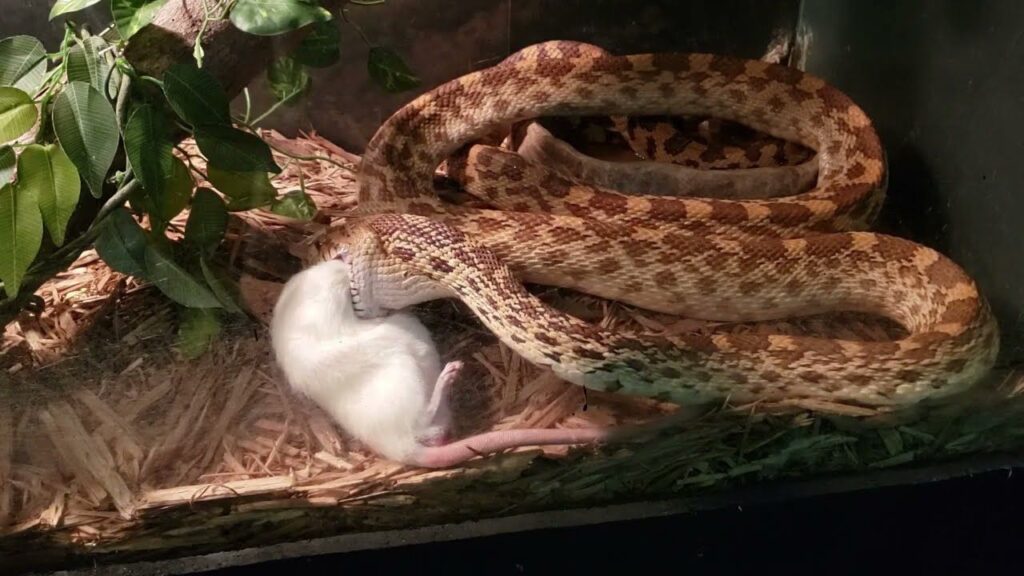
When discussing the diet of bull snakes in Colorado, you’ll find that their prey species include rodents, small mammals, birds, and insects.
They use their constricting technique to suffocate their prey, making them efficient hunters.
This behavior not only helps them survive in various habitats but also plays a pivotal role in controlling rodent populations and maintaining ecosystem balance.
Prey Species
Bullsnakes thrive on a varied diet that includes small mammals, birds, lizards, and even insects. Their primary food sources are small mammals such as mice, rats, pocket gophers, ground squirrels, and rabbits. By preying on these animals, bullsnakes play an essential role in rodent control, which helps maintain ecological balance and food web dynamics in their habitats.
Predation impact by bullsnakes extends beyond just rodents. They also feed on:
- Birds and their eggs: This helps control bird populations and reduces the spread of avian diseases.
- Lizards: By consuming these reptiles, bullsnakes help manage the population of smaller predators.
- Insects: Though a less significant part of their diet, eating insects contributes to controlling pest populations.
This diverse diet makes bullsnakes versatile predators, allowing them to adapt to various environments and prey availability. Their predation helps sustain the ecological balance by keeping prey species in check and preventing overpopulation.
Additionally, by reducing rodent populations, bullsnakes decrease crop damage and lower the transmission of rodent-borne diseases. Understanding their diet highlights the importance of bullsnakes in maintaining healthy ecosystems in Colorado.
Hunting Techniques
Masterful hunters, these versatile reptiles employ powerful constriction and strategic pinning techniques to capture and subdue their prey. Bull snakes in Colorado utilize efficient strategies like ambush tactics, waiting patiently for unsuspecting rodents and small mammals such as mice, rats, pocket gophers, ground squirrels, and rabbits. When the moment is right, they strike quickly and use their constriction technique to suffocate their prey.
In addition to ambush tactics, bull snakes have a unique behavior known as wall pinning. They hunt rodents in narrow burrows, pinning them against the walls to immobilize them before employing their constriction technique. This method makes them incredibly efficient hunters, allowing them to control rodent populations effectively.
Bull snakes don’t limit their diet to just mammals. They also consume birds, eggs, nestlings, lizards, and insects, showcasing their adaptability. By varying their diet, they can thrive in different environments and contribute to the balance of prey species in their habitats.
Understanding these hunting techniques gives you insight into how bull snakes maintain ecological balance. Their role as predators is vital, helping to keep the populations of various small animals in check.
Conservation
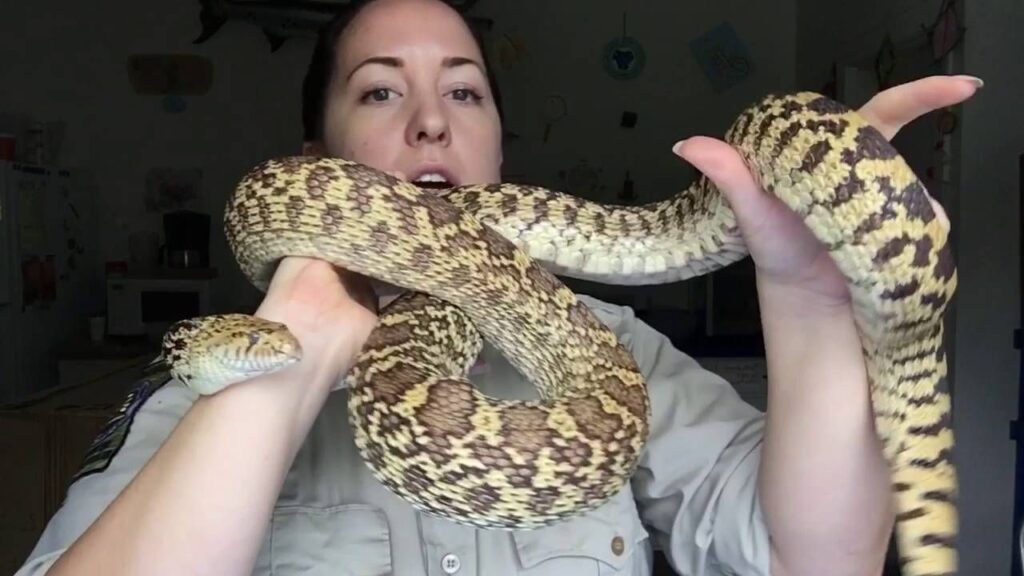
Conservation efforts in Colorado focus on preserving bullsnake habitats to maintain ecological balance and prevent rodent overpopulation. Bullsnakes play an important role in controlling rodent populations, which helps keep the ecosystem in check. By protecting these snakes, you’re not just saving one species, but supporting a whole network of animals and plants that rely on each other.
To effectively preserve bullsnake habitats, community involvement is key. You can contribute by participating in local conservation projects or by simply being mindful of wildlife when spending time outdoors. Every small action helps in maintaining the delicate balance of nature.
- Join local conservation groups: Participate in habitat restoration projects to make sure bullsnakes have a safe place to live.
- Educate others: Spread awareness about the significance of bullsnakes in the ecosystem.
- Support legislation: Advocate for laws that safeguard natural habitats and endangered species.
Habitat preservation is essential for bullsnakes to thrive. When their habitats are destroyed, it disrupts the ecosystem and leads to an increase in rodent populations, which can cause further environmental issues. You can help by reducing your environmental footprint and supporting organizations dedicated to preserving natural areas.
The ecosystem impact of losing bullsnakes would be significant. Not only would rodent populations surge, but other predatory species that rely on similar food sources might also suffer. Understanding bullsnake behavior and promoting human coexistence with these reptiles ensures their continued role in the local ecosystem.
Identification

To appreciate the significance of conservation, it’s helpful to know how to identify bullsnakes in their natural habitat. Bullsnakes are one of Colorado’s largest snakes, with an average length ranging from 4 to 6 feet. You’ll notice their size variations, but their distinctive markings and coloration make them stand out. Typically, bullsnakes have a yellowish background color adorned with brown and reddish blotches. These blotches can vary in intensity and pattern, but they generally form a series of dark bands along the body.
When you’re observing a bullsnake, pay attention to its scale patterns. The scales on a bullsnake are keeled, meaning they’ve a raised ridge running down the center, giving the snake a rough texture. This is different from the smooth scales found on other snake species in Colorado. The head of a bullsnake is also a key identifier; it’s slightly pointed with a dark line running from the eyes down to the jaw, which contrasts with the lighter coloration of the rest of the head.
In terms of habitat, bullsnakes are adaptable and can be found in various environments, including grasslands, forests, and rocky areas. When you’re out in these habitats, keep an eye out for their length and patterns to distinguish them from other snakes.
Defense Mechanisms
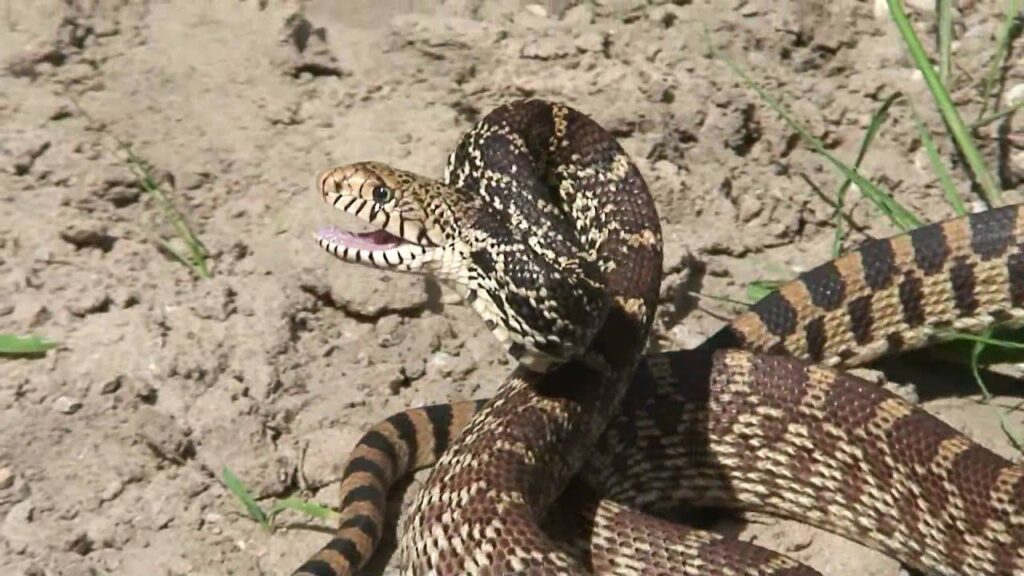
When threatened, bullsnakes employ a range of defense mechanisms to deter predators and protect themselves. These impressive reptiles have several strategies to avoid becoming a meal. First, they might remain completely motionless, relying on their camouflage to blend into the surroundings. If this tactic doesn’t work, they’ll switch to more active defensive postures.
Bullsnakes are skilled at using warning signals to scare off potential threats. They can flatten their heads and vibrate their tails, which mimics the behavior of rattlesnakes. This mimicry tactic, along with hissing loudly, makes predators think twice before attacking. By spreading their jaws to create a triangular head shape similar to rattlesnakes, they further enhance this illusion. These behaviors serve as an effective means of predator avoidance.
- Flattening their heads and vibrating their tails
- Hissing loudly to mimic rattlesnakes
- Spreading their jaws to create a triangular head shape
These warning signals often persuade predators like red-tailed hawks and Swainson’s hawks to look for an easier target. Bullsnakes may also coil and strike if they feel cornered, showing they’re ready to defend themselves aggressively. The combination of these defensive postures and warning signals makes bullsnakes formidable opponents in the wild.
It’s fascinating how their defensive strategies can vary based on individual characteristics and environmental factors. Some bullsnakes might be more inclined to use mimicry tactics, while others rely on physical aggression. This adaptability helps them survive in diverse habitats across Colorado.
Encounter Tips
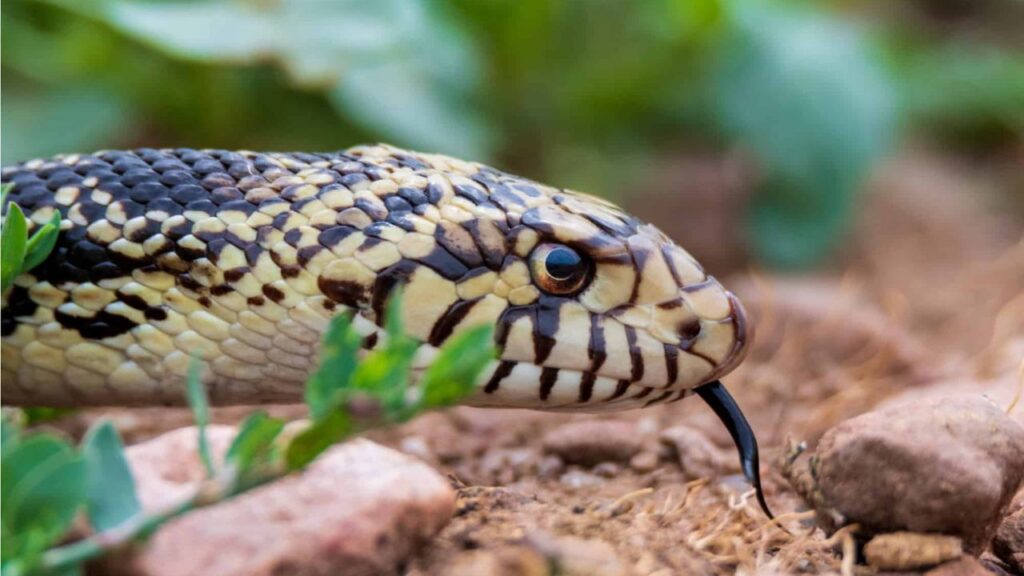
If you come across a bullsnake in Colorado, keep your distance and observe it calmly from afar. This is important for both your safety and the snake’s well-being. Bullsnakes are non-venomous but can become defensive if threatened. By maintaining a safe distance, you reduce the risk of provoking the snake and guarantee a peaceful wildlife encounter.
When observing a bullsnake, use these observation techniques: first, note its distinctive yellow color with brown or black patches. They can grow up to 6 feet in length, making them quite impressive to see. Avoid any sudden movements; instead, watch its behavior quietly. Bullsnakes may hiss or mimic rattlesnakes by vibrating their tails, but remember, they don’t have a rattle.
Safety precautions are important. Never attempt to touch or capture the snake. Despite their non-venomous nature, bullsnakes can bite if they feel cornered or threatened. It’s best to respect their space and appreciate their role in the ecosystem from a distance.
Bullsnakes play a crucial role in controlling rodent populations, which benefits the local environment. By observing them without interference, you allow them to continue their important work.
If you encounter a snake that looks like a rattlesnake, remember that bullsnakes lack the characteristic rattle on their tail.
Conclusion
Bull snakes in Colorado are fascinating creatures you might encounter. With their striking appearance, varied diet, and specific habitat preferences, they play an essential role in the ecosystem.
Knowing how to identify and respect them guarantees both your safety and theirs. Remember, their defense mechanisms are more bluff than bite. So, if you cross paths with one, give it space and appreciate the encounter from a distance.
Respect nature, and it will respect you.
